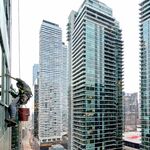steveintoronto
Superstar
Fascinating...you will provide reference of course? If anyone had to the power to intervene, it would have been Metro, not the Province. The major arteries were Metro roads, their competence.It's also worth mentioning that Toronto - City, not Metro - was going to make Yonge and Bay one-way streets for a pilot project in 1988. A judge blocked the proposal right before it would've gone into effect on the basis that the city needed provincial approval to make this change, and the city never ended up pursuing it.
Besides which:
http://www.torontosun.com/2012/05/08/yonge-bay-to-go-one-wayYonge, Bay to go one-way?
Minnan-Wong says it would improve traffic flow
By Don Peat, City Hall Bureau Chief
First posted: Tuesday, May 08, 2012 12:40 PM EDT | Updated: Tuesday, May 08, 2012 08:32 PM EDT
TORONTO - Could Toronto drivers one day be rolling only one way along Yonge and Bay Sts.?
Public Works chairman Councillor Denzil Minnan-Wong wants to study the idea of turning two of downtown’s busiest north-south routes into one-way roads.
“It would, I think, improve traffic flow and you’d have the ability to, I think, also include some sort of separated bike lanes — and possibly add transit, as well,” Minnan-Wong said Tuesday.
“I think it would be a really interesting approach or study ... I think we need to look at innovative approaches to dealing with gridlock and congestion in the downtown core.”
Last year, the public works committee gave the green light to a yet-to-be completed downtown transportation study to look at ways to improve the flow of traffic.
“We do have a congestion and traffic problem; I would hope that council would be looking at ways ... of improving traffic in the downtown core and not making it worse,” Minnan-Wong said.
Councillor Adam Vaughan blasted the idea and warned the change, if it ever happened, would “wipe out every small business” along those streets.
“One-way streets destroy commercial activity on them,” Vaughan said.
Councillor Kristyn Wong-Tam, whose ward includes Yonge St., said there should be research and studies before Yonge and Bay Sts. are turned into one-way streets.
“We can’t necessarily do it because of the whim of a councillor,” she said.
Wong-Tam has her own changes in mind for Yonge St. — at least temporarily.
She will ask the Toronto and East York community council next week to approve closing two of the four lanes on Yonge St. — between Gerrard and Richmond Sts. — from Aug. 17 to Sept. 16 for a Celebrate Yonge St. event. The plan would widen the sidewalks during the closure and allow around 12 business operators to bump out patios.
“This is not first street in Canada to go through this intervention,” Wong-Tam said.
Asked if she’d ever push for the change to be permanent, Wong-Tam said she was taking the issue “one step at a time.”
Ah yes, the great champion of streetcar corridors...not.
https://www.thestar.com/news/city_h...ilot-project-that-prioritizes-streetcars.htmlToronto’s deputy mayor is pushing for the city to set clear targets for the pilot project that would prioritize streetcars over car traffic on King St., in order to prevent its supporters from “declaring victory” without any clear evidence.





